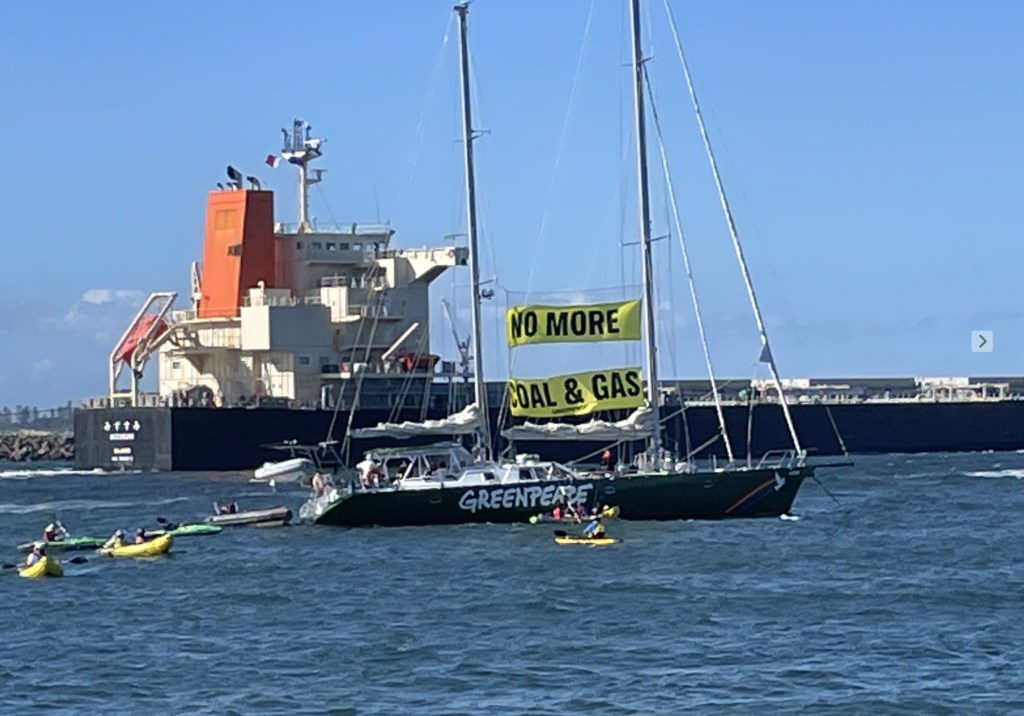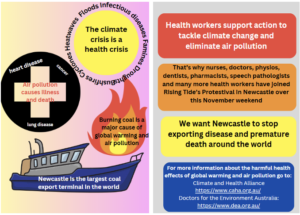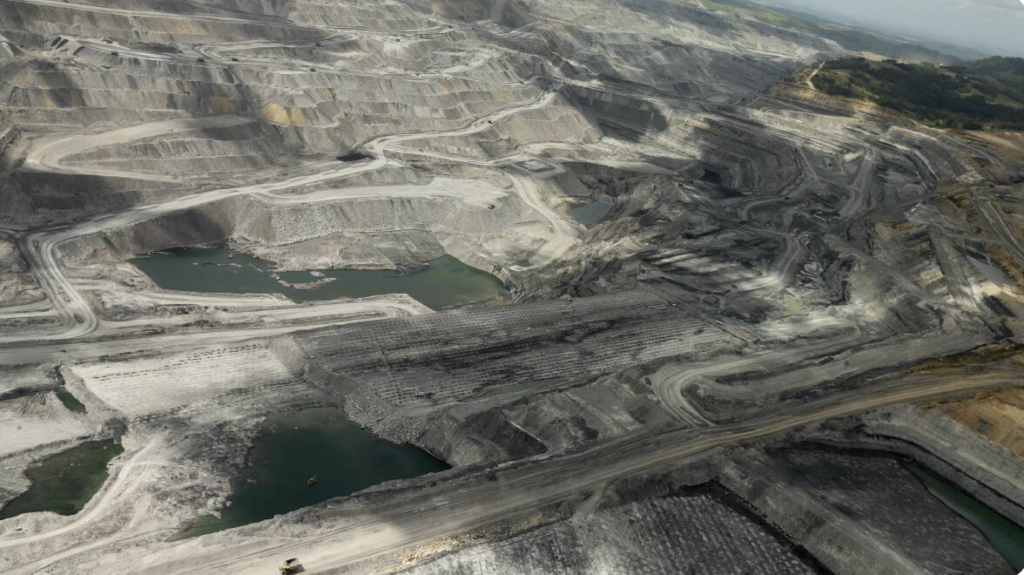Environment: Climate protesters blockade Newcastle’s coal port despite government bans
December 1, 2024
Draconian laws don’t discourage climate protesters. Hydrogen’s rainbow of colours. CCS continues to underperform. Clean energy investments increasing but so are investments in fossil fuels.
Destroying lives v inconveniencing the public
George Monbiot in The Guardian recently compared the draconian jail sentences legislated and imposed during the previous UK Conservative government’s term of office (and now defended by Starmer’s Labour government) on peaceful, though admittedly disruptive, climate protesters with the ludicrously lenient suspended sentences imposed on violent criminals, sometimes by the very same judge. All this occurring while rapidly escalating climate change destroys people’s health, homes, livelihoods, communities and environments. And while the individuals and companies responsible for the climate mayhem are free to not only continue their selfish, civilisation-destroying ways but also wield enormous power and influence over national governments and global intergovernmental organisations.
Monbiot makes the crucial point that although judicial authorities and others are quick to assert that the sentences cited in all his comparisons represent the proper application of legislated sentencing guidelines, this does not make it right – legal, yes; morally right, no. Rather, the new laws ‘ensure that nonviolent protest is routinely treated as a more serious crime than most forms of violence. The issue is precisely that this asymmetry is institutionalised’.
Monbiot also criticises the ‘context stripping’ that occurs in the courts (where climate protesters are now forbidden to explain their motivations in the UK) and in the media where reporting of the actions of climate protesters frequently lacks local and global context and little mention is made of the role of global warming and its causes in the reporting of cyclones, bushfires, floods, famines, etc. According to Monbiot: ‘What we see in all these cases is a fatal lack of moral seriousness. We are swept along on a storm surge of virulent trivia [and have] allowed ourselves to be perennially distracted from what will be, if unaddressed, the only issues that count’.
Blockade of Newcastle coal port
Enough of the UK, what of Australia? State governments across Australia have been passing increasingly punitive laws to deter and punish climate protesters. Going a step further, the NSW government imposed an exclusion zone around Newcastle Harbour to prevent protestors kayaking into the shipping channel to block the progress of coal carriers last weekend – a decision that was, he smugly notes, declared invalid by the NSW Supreme Court.
I imagine many readers saw some media coverage of the blockade of the world’s largest coal export facility last weekend by thousands of climate activists. I was there again this year and spent some time on a kayak in the shipping channel - but didn’t get arrested.

I was also one of a group of health workers seeking to highlight the very serious harmful effects of climate change and air pollution on people’s health, effects that are caused by burning coal. As well as participating in the activities in and around the harbour, we visited the Saturday Christmas Market in Newcastle CBD to hand out flyers (see below) and engage shoppers in a discussion about the health issues. Many but not all were sympathetic to our message.

Of course, Newcastle may be the biggest coal port in the world (currently exporting approximately 100 million tonnes per year) but it is simply a staging post for the coal that is mined further up the Hunter Valley – mined with devastating outcomes for the local environment and communities.

It’s impossible to believe that Newcastle will stop exporting coal while mining companies further up the Hunter are still digging it out of the ground and countries overseas are buying it. Rapid change is, however, needed and that is why the three demands of Rising Tide, the blockade organisers, are:
- No new coal. No new gas.
- Tax fossil fuel export profits at 78% to fund community and industrial transition.
- End all coal exports from Newcastle by 2030.
Colourful hydrogen
When I wrote about hydrogen power a little while ago, I didn’t realise that there is a veritable rainbow of ‘clean’ hydrogens:
Blue hydrogen is produced by mixing natural (i.e. fossil) gas with steam (produced with heat provided by burning fossil fuels) and then permanently burying the CO2 released using carbon capture and storage (CCS).
Green (electrolytic) hydrogen is produced by splitting water molecules with renewable energy.
Turquoise hydrogen is produced by heating but not combusting plant and waste biomass – a process known as gasification. This also requires CCS of the CO2 by-product.
White hydrogen is extracted from the natural reservoir of hydrogen in the Earth’s subsurface.
Pink hydrogen is like green hydrogen but uses nuclear energy.
And let’s not forget grey hydrogen produced like blue but without even bothering to capture and store the carbon. As the figure below shows, however, if coal is the source of the energy needed to produce the steam, it’s really black hydrogen.
Silly me, I thought hydrogen was colourless.
Hydrogen’s colour palate is not of purely whimsical interest, however. The global warming impact of hydrogen power is highly dependent on the method of its production, the hydrogen and methane fugitive emission rates during production and transport, its actual end-use and the climate warming time scale under consideration. A recent study found that depending on these factors, hydrogen use might be almost free of greenhouse gas emissions or increase them by 50%. Worst of all, if the renewable energy used to produce the hydrogen needs to be replaced in the grid with electricity from fossil fuels, emissions will almost quadruple.
The problems associated with, and limitations on, the use of hydrogen as a power source that I mentioned previously apply to all its H-ues.
CCS continues to disappoint
While we’re talking about CCS, recent data from Chevron’s CCS project at their Gorgon Liquified Natural Gas facility off the coast of WA (the world’s largest CCS project) yet further confirms its dismal underperformance. When the project was approved, it was on the condition that it captured 80% of the CO2 removed from the gas reservoir from 2016. The CCS facility only began to operate in 2019 and since then the capture rate has fallen steadily from 70% in 2019/20 to 30% in 2023/24.
Not only that, the actual amount captured has fallen steadily from approximately 2.7 to 1.6 MtCO2 per year, and the cost, which was expected to be about $70 per tonne of CO2 captured, has increased from $104 to $222 per tonne. Remembering that the CO2 that comes up the pipe with the burnable natural gas is but a small fraction of the total greenhouse gases produced in the production, processing, transport and burning of LNG.
Global investments in energy generation, storage and use
The International Energy Agency’s headline is that ‘The world now invests almost twice as much in clean energy as it does in fossil fuels’ and if we follow the IEA’s logic that has been the case since 2016.
But we need to be careful not to interpret this as meaning that the world is now investing more in solar and wind power than coal, oil and gas. If we look closely at the IEA’s histogram, we see that the Agency’s definition of ‘clean energy’ goes well beyond generating energy from wind and solar (what it calls ‘renewable power’). In fact, in 2024 global investments in fossil fuels (US$1116 billion) were almost 50% higher than investments in sun and wind (US$771 billion).
The big investor in ‘renewable power’ in 2024 was, no surprise, China (US$359 billion), with the European Union (US$106 billion) and the USA (US$85 billion) way behind in second and third places.
That said, investments in solar PV energy generation (US$503 billion – light blue below) now exceed investments in all other energy generation technologies (US$426 billion – dark blue). Investments in wind power come second but with only 40% of the investment in solar.
The investment by the oil and gas industry in clean energy has been increasing steadily over the last decade and is now approximately US$30 billion/year but it still represents less than 4% of the industry’s total capital expenditure and just over 1% of net income – nothing more than token investments really.
Industries’ and investors’ expectations for the long-term future of each fuel source are pretty clear in the following graph that shows global investments for 2021-24. Solar PV leads the way in both the annual amount invested and the rate of increase, followed by wind. Nuclear is having a bit of a resurgence but at relatively low levels of investment. Coal is clearly seen to be on the decline, investments having fallen by 40% in four years. (Sorry, I don’t know why oil isn’t on this particular graph.)
However, investment in all fossil fuels combined has been on the increase since 2020 and the IEA predicts that this trend will continue. (Low-emissions fuels includes bioenergy, low-emissions hydrogen and hydrogen-based fuels generated using fossil fuels, and carbon capture and storage.)
Remember though that these figures relate to investments, not the actual amount of energy generated by each source at present, over three-quarters of which is still produced from fossil fuels. And although the percentage is falling slowly the actual amount produced by fossil fuels is still increasing.
Broken record alert: don’t tell me how much more renewable energy is being produced, tell me how much fossil fuel is being burnt.
Who are the ones threatening public safety?
Who are the real criminals? Who are their lickspittles?
With thanks to Megan Herbert for her on the mark cartoon in the Sydney Morning Herald on 25 November 2024.

